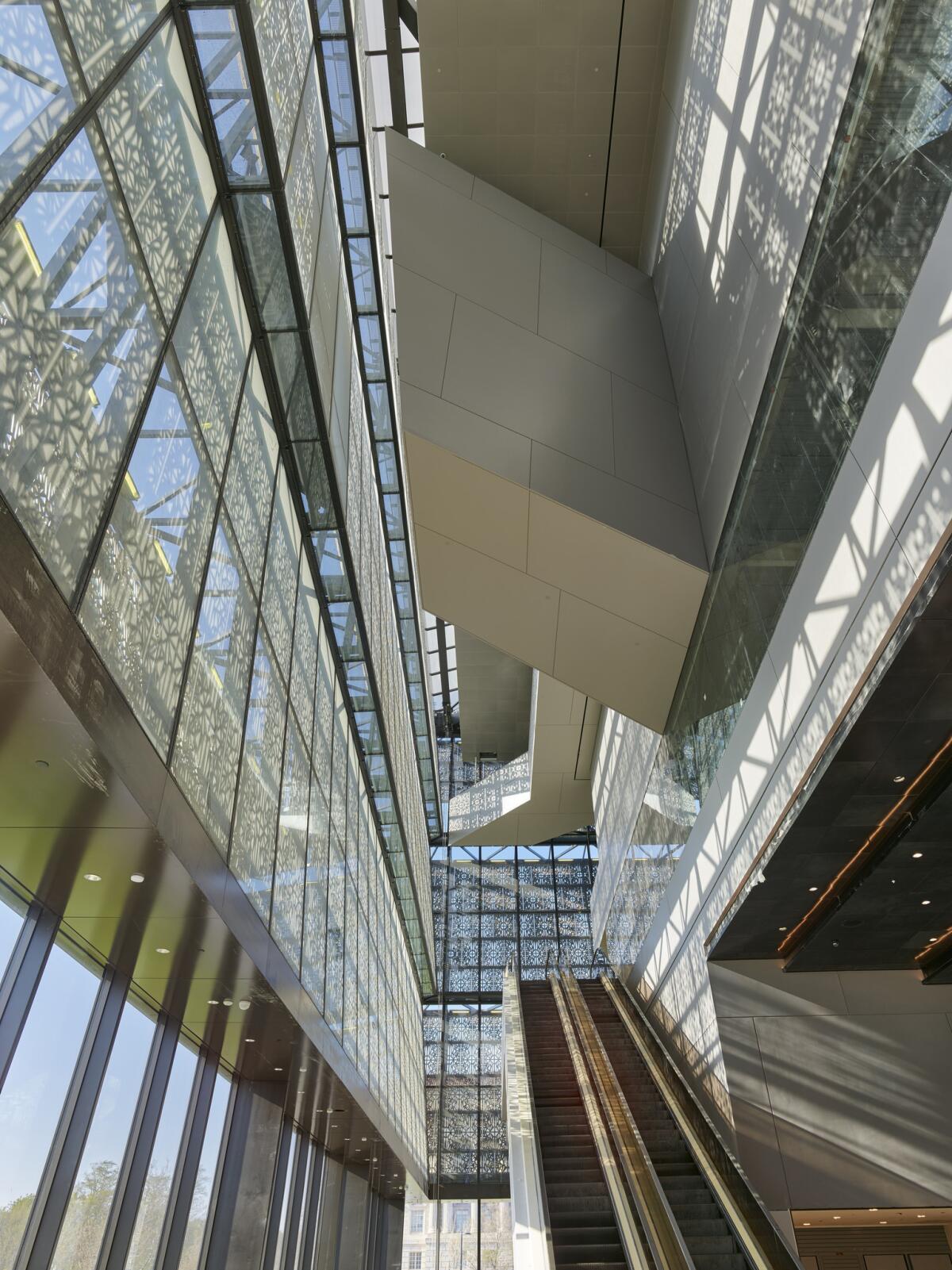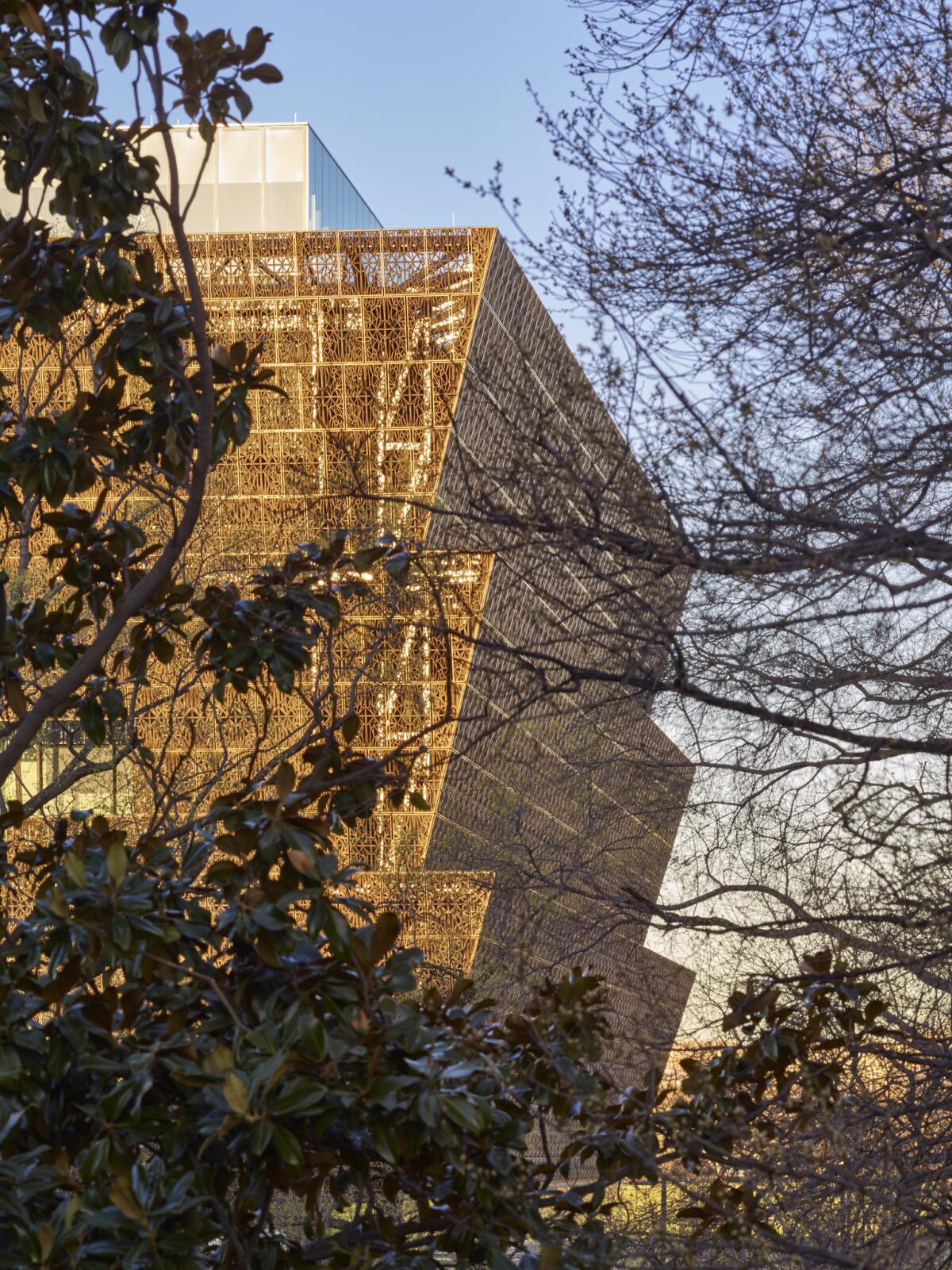Review: D.C.’s new African American museum is a bold challenge to traditional Washington architecture
- Share via
In full shadow it's a workmanlike brown, the color of shoe leather. In direct sunlight the shade is closer to bronze. Late in the day its western edge, turned toward the Washington Monument and the Lincoln Memorial, begins to reflect the setting sun and turns a surprisingly bright gold.
The shifting personality of the National Museum of African American History and Culture, designed by a consortium of architecture firms calling itself Freelon Adjaye Bond/SmithGroup and set to open Sept. 24 near the center of the Mall, is no fluke or simple trick of light.
The most impressive and ambitious public building to go up in Washington in a generation — if also the owner of a truly awkward acronym — the NMAAHC draws its considerable power from a willingness to embrace the nearly bottomless complexity of both its mission and its site.
As a new branch of the Smithsonian located three blocks south of the White House, charged with marking the origins and history of the slave trade and giving some measure of the modern African American experience, the museum could hardly be more fraught as a cultural institution or work of architecture.
Despite some flaws and unfortunate signs of cost-cutting, the design succeeds almost precisely to the degree that it is enigmatic and even fickle, spanning huge gulfs in the national character without being naive enough to try to close them. The building embraces memory and aspiration, protest and reconciliation, pride and shame.
Its attitude toward architectural battle lines is similarly catholic. It is an essentially modern building cloaked in a decorative pattern, aloof and standoffish in certain ways and carefully contextual in others.
As it rises from the northern edge of the Mall along Constitution Avenue — with the Washington Monument directly to the west, the Smithsonian’s 1964 National Museum of American History to the east, the massive 1932 Commerce Department to the north and open grass to the south — the NMAAHC is undeniably an imposing architectural object, monumental and temple-like.
Yet it also suggests something that has been unearthed, a box pulled from the ground and dusted off; much of its 420,000 square feet of interior space is buried below street level.
SIGN UP for the free Essential Arts & Culture newsletter »
The $540-million museum is wrapped in three levels of bronze-coated aluminum panels atop an all-glass ground floor. The panels (which the architects originally hoped would be entirely bronze) are decorated with a lattice pattern inspired by ironwork made by slaves. They tilt outward at an angle designed to match the capstone on the Washington Monument.
According to architect David Adjaye, the museum’s Ghana-born, London-based lead designer, the inspiration for the building’s unusual silhouette is in part a carved wooden sculpture by the Yoruba artist Olowe of Ise. On display inside the museum, it shows a figure of a king wearing a headdress with the same three-level, inverted-pyramid silhouette.
The building has two entrances. An expected 70% of visitors will come in from the Mall side, where they’ll walk under a giant long-span shade structure, inspired by the front porches of Southern houses, that is almost entirely detached from the rest of the building. The rest will come in from Constitution Avenue.
This double-sidedness is fundamental to the museum’s civic role and architectural personality. The NMAAHC occupies what Adjaye (whose best-known work until now has been Denver’s Museum of Contemporary Art) calls a “knuckle” or “joint,” with a dense collection of neo-classical federal office buildings on one side and the open space of the Mall on the other.

Some of the powerful strangeness of the museum as an urban object fades once you reach the gigantic atrium. The architectural language here is largely of the familiar Washington institutional type, chunky, squared-off forms reminiscent of I.M. Pei’s East Wing of the National Gallery or the National Museum of American History by Walker Cain of McKim, Mead and White.
Still, there’s drama as you look up, realizing that the metal panels are more of a detached scrim on the outside of the building than a sealed wrap — that the museum’s above-ground half is essentially a giant glass box sheathed in decorative scaffolding.
The exhibitions, designed by Ralph Appelbaum Associates, begin on the lowest underground level. The cavernous subterranean spaces were largely shaped by the firm Davis Brody Bond, which also designed the underground portion of the National September 11 Memorial & Museum in New York. Adjaye’s main collaborator on the rest of the building (and the museum’s architect of record) was Philip Freelon, an African American architect who designed the Museum of the African Diaspora in San Francisco and now works for the large firm Perkins + Will.
A wide ramp leads back up to the atrium, where escalators and elevators will take visitors to additional galleries on the upper floors. Along the edges of these rooms are large cutouts in the exterior panels, openings that carefully frame views toward the Washington Monument and various memorials. The top level holds the museum’s offices.
The progression through the building offers a series of architectural hits and misses. The gaps along the edges of the building offer a dramatic series of vertical interior views, a reminder that if the whole of the museum were aboveground it would be closer to a tower than a box. The auditorium, which uses a miniature version of the three-tiered bronze exterior as a decorative frieze, borders on kitsch.
The director the NMAAHC, Lonnie Bunch, has frequently said that the museum’s central goal is to use the African American experience as a means of understanding the broader American one. Adjaye’s conception of the building — its posture toward the rest of the Mall — sharpens that idea to a surprising, even radical point. He refers to the museum as a “monitor.”
What he means is that those cutouts in the facade are offering a lot more than postcard views. They are meant to keep an eye on — and even, in a direct and uncomfortable sense, to judge — the buildings around them.

The architecture of those buildings argues powerfully for American exceptionalism. They are monuments not just to the figures they celebrate but to the idea that our government proceeds with some kind of moral imperative.
The unwelcome guest at that self-congratulatory party has always been race. To acknowledge the full history of our government’s relationship with African Americans, Ta-Nehisi Coates writes in his recent book “Between the World and Me,” “means turning away from the brightly rendered version of your country as it has always declared itself and turning toward something murkier and unknown.”
The triumph of the design by Adjaye, Freelon and their colleagues is that the museum building embodies both that “something murkier” and that “turning toward.”
It is a reflection of the shadow cast by America’s original sin but also of our ongoing, imperfect and controversial efforts to address it, which in the last few years alone have included the Black Lives Matter movement, a number of major if calibrated addresses from President Obama, Coates’ call for reparations for African Americans and the ongoing refusal by some professional athletes to stand during the national anthem. The museum’s skin — has that typically benign architectural term ever been more charged? — allows it to stand apart from the Mall’s white-marble monuments like a rebuke.
More subtly, the NMAAHC exists as the thing to be confronted and the vehicle for that confrontation at the same time. That’s why it’s significant that the design makes a point of setting the bronze panels distinctly apart from the rest of the building’s glass-box structure. This isn’t just one more Washington museum filled with vitrines.
As becomes clear once you step inside, the whole thing is a vitrine. It is a place less to celebrate America and its place in a Western lineage — the central ambition of the Mall as a whole — than to put the fundamental contradictions of the national experiment under glass and give them a hard look.
The building itself is perhaps the most powerful display of all, a careful, strategic and sometimes defiant exploration of the relationship between black culture and government prerogative, which is another way of saying it is a piece of architecture supple enough to please the archivist and the activist alike.
For the Record
9 a.m. Sept. 16: This article says David Adjaye was born in Ghana. He was born in Tanzania to Ghanian parents.
christopher.hawthorne@latimes.com
Twitter: @HawthorneLAT
ALSO
Biggest challenge in opening a museum about African American history? How to talk about slavery
From UC Davis to the National Mall: Key architecture projects this fall
At Sandy Hook Elementary, a new campus and a new start at site of horror
Thomas Mann house by midcentury great J.R. Davidson: L.A.'s next big teardown?
The biggest entertainment stories
Get our big stories about Hollywood, film, television, music, arts, culture and more right in your inbox as soon as they publish.
You may occasionally receive promotional content from the Los Angeles Times.








